NEW FRAME
The complex history of Cape Muslim cuisine
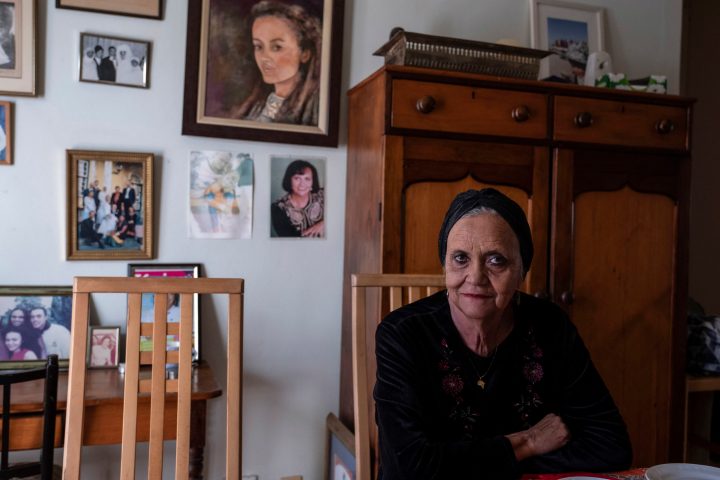
The lineage of food rooted in more than 350 years of exile and slavery – its connections and disconnections, presence and absence – can be traced from the Malay Archipelago to Cape Town.
First published by New Frame
Propped outside Rose Corner Café in the Bo-Kaap, Cape Town, is a familiar signboard: “Fresh koeksisters, available daily”. It’s advertising the beloved, decadent doughnut infused with spices such as ginger and cinnamon, dunked in a simple syrup and rolled in a fuzzy halo of desiccated coconut. So strictly speaking, it should read “koe’sisters”.
Koeksisters are firm, saccharine-sweet, deep-fried plaits of dough traditionally made by Afrikaners, white descendants of the Dutch and other Europeans who colonised South Africa from 1652 onwards. This typographical error in koe’sisters is apt, though. Words in this part of the world divulge and conceal more than meets the eye.
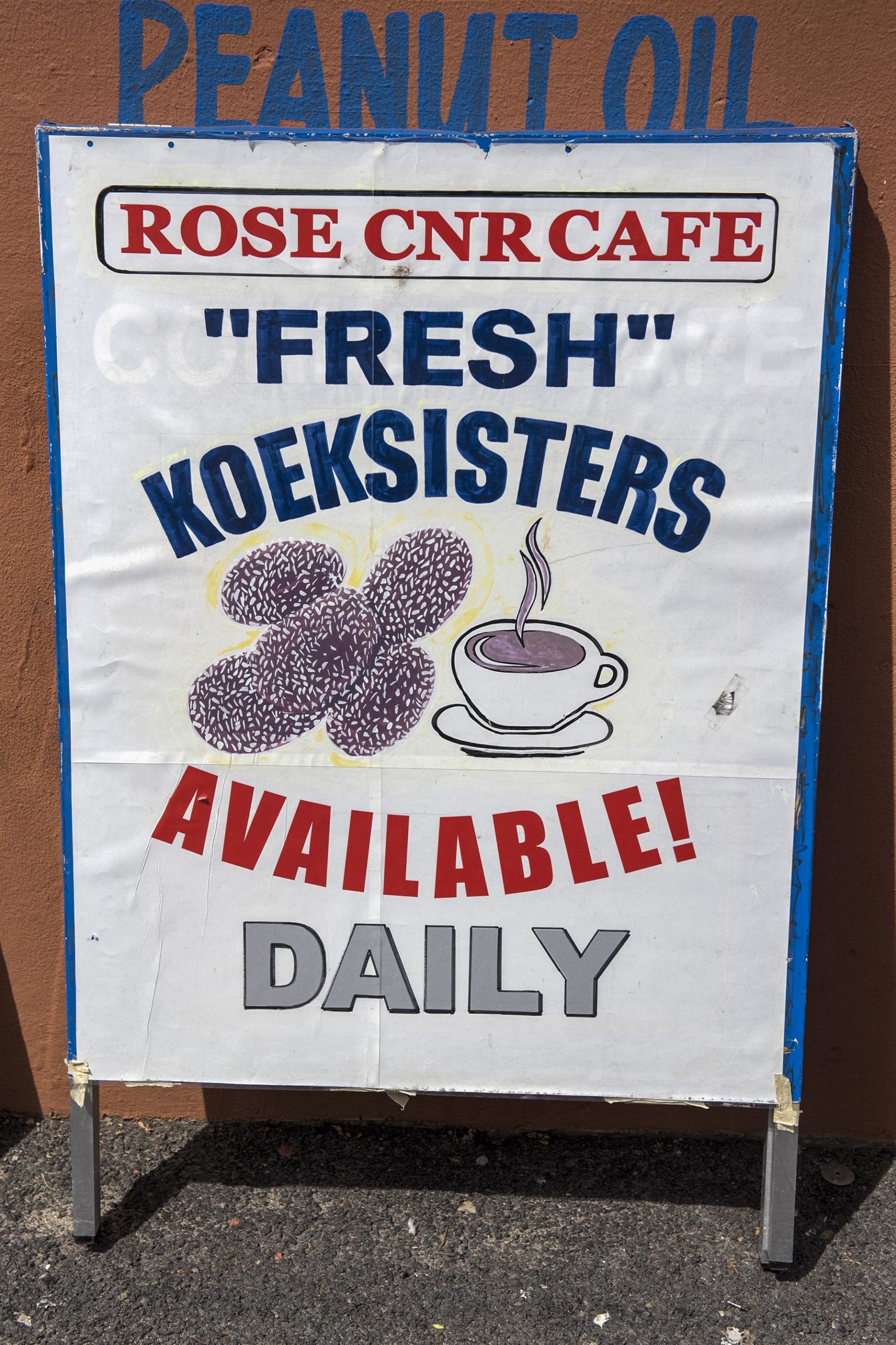
Undated: The sign advertising fresh koe’sisters outside Rose Corner Cafe in the Bo-Kaap, Cape Town. (Photograph by Ishay Govender)
Consistent with the rest of the country, much of the Cape’s food and associated cultural customs appear shrouded in mystery. Koe’sisters, a Sunday tradition in these parts, were created by the Cape Malays or Cape Muslims. Broadly, the descendants of exiles and the enslaved from the colonised South East Asian territories – such as the Dutch East Indies (Indonesia), Malaysia, India and Ceylon – and East African states like Madagascar and the surrounding regions were captured and shipped to the Cape, where the Dutch East India Company had established a trading port and victualling station. So while “Malay” is referenced in relation to this group, the cultural and culinary roots have a broader geography.
Texts on the precise origin of dishes are nebulous, but some key factors emerge. Historian Gabeba Baderoon’s Regarding Muslims: From Slavery to Post-Apartheid points to how the segregation of South Africa’s racial and cultural groups ordained over several centuries – and the violent trauma of forced removals and relocations that festers today – have created silos in which dearly held cultural codes are either locked or, invariably, lost over time. Detailed written accounts by the originators of the dishes are also missing and the settlers’ perspectives continue to dominate the archives.
Roots in slavery
The pastel-coloured houses running up the foot of Signal Hill in the Bo-Kaap are home to one segment of the community of Cape Malays, an ideological and political term, fraught in many circles.
Until the mid-17th century, southern Africa had escaped the shackles of the slave trade, unlike East and West Africa. The precise location of their ancestors became hazy with time as the enslaved were stripped of their identity and records were inked by the creative hands of new masters, who doled out names that were facetious or corresponding with a day or month in a hegemonic naming practice.
Melayu, one of the prominent languages spoken by the sailors and the enslaved from South East Asia (and commonly used from New Guinea to Madagascar, as Yusuf da Costa and Achmat Davids point out in Cape Malay History), became the language of Islam in the Cape and, later, the precursor to the creolised Dutch created by the enslaved and subsequently used by the slave masters. This would transmute into Afrikaans, the first record of which was actually in Arabic script.
It’s said that the use of Melayu, which sounds like “Malay”, and the geographical region known as the Malay Archipelago, embodying many of the enslaved’s home territories, are some of the reasons that the misnomer “Malay” persists when describing this Cape Muslim community.
Researcher and poet Rustum Kozain says: “As a child, I learned that ‘Cape Malay’ was an apartheid term and that the primary determinant in my identity was ‘Muslim’.”
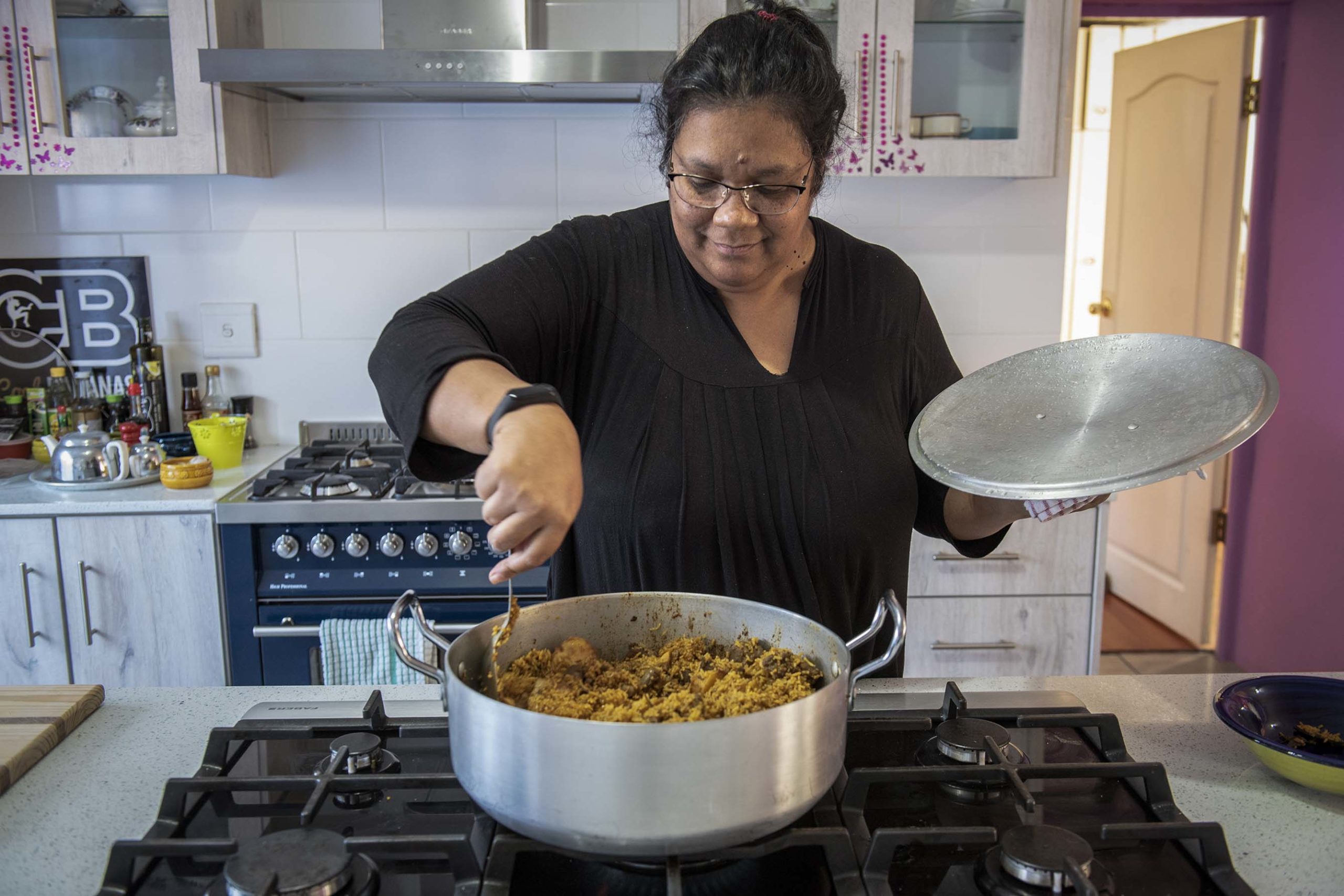
7 September 2019: Fatima Sydow presents her popular cookery show, Kaap, Kerrie en Koe’sisters, with her twin sister Gadija Noordien from her home kitchen in Lansdowne, Cape Town. (Photograph by Ishay Govender)
As a government directive, it served to categorise the community of Muslims under the same umbrella (even those not directly linked to the slave trade) and distinguish them from those deemed “coloured”. But mixing by way of marriage, and consequently shared food customs, happened frequently, blurring the restrictive boundaries set by the state. Curries influenced by Muslims from India, for example, became a staple that lives on in the Cape today; a Cape Malay curry, however, is distinct from the east coast Durban curry.
Finding food origins
The roots of the Cape Malay people lie more accurately in Indonesia than Malaysia, places such as Aceh in Sumatra, Sulawesi and Java.
The Acehnese are well regarded for their bold resistance against the Dutch. Some of the Cape’s most influential Islamic teachers were political exiles and prisoners, rebels from Sulawesi, Tidore, Batavia (Jakarta), Ceylon and Bengal, and they continued to resist Dutch rule in the Cape. Linked to the rise of Islam in the region are the associated festivals, religious ceremonies and dietary behaviours such as the halaal doctrine that forbids alcohol and pork, for example.
The food of Sumatra, particularly Aceh, contains spices found in Indian and Arabic cookery such as ginger, cardamom, star anise, cloves and nutmeg. Sulawesi foods tend to be fiery, says James Oseland in Cradle of Flavour. Indonesian culinary historian William Wongso echoes this in Flavors of Indonesia. This endures in the Cape Muslim cookery we associate with the region today.
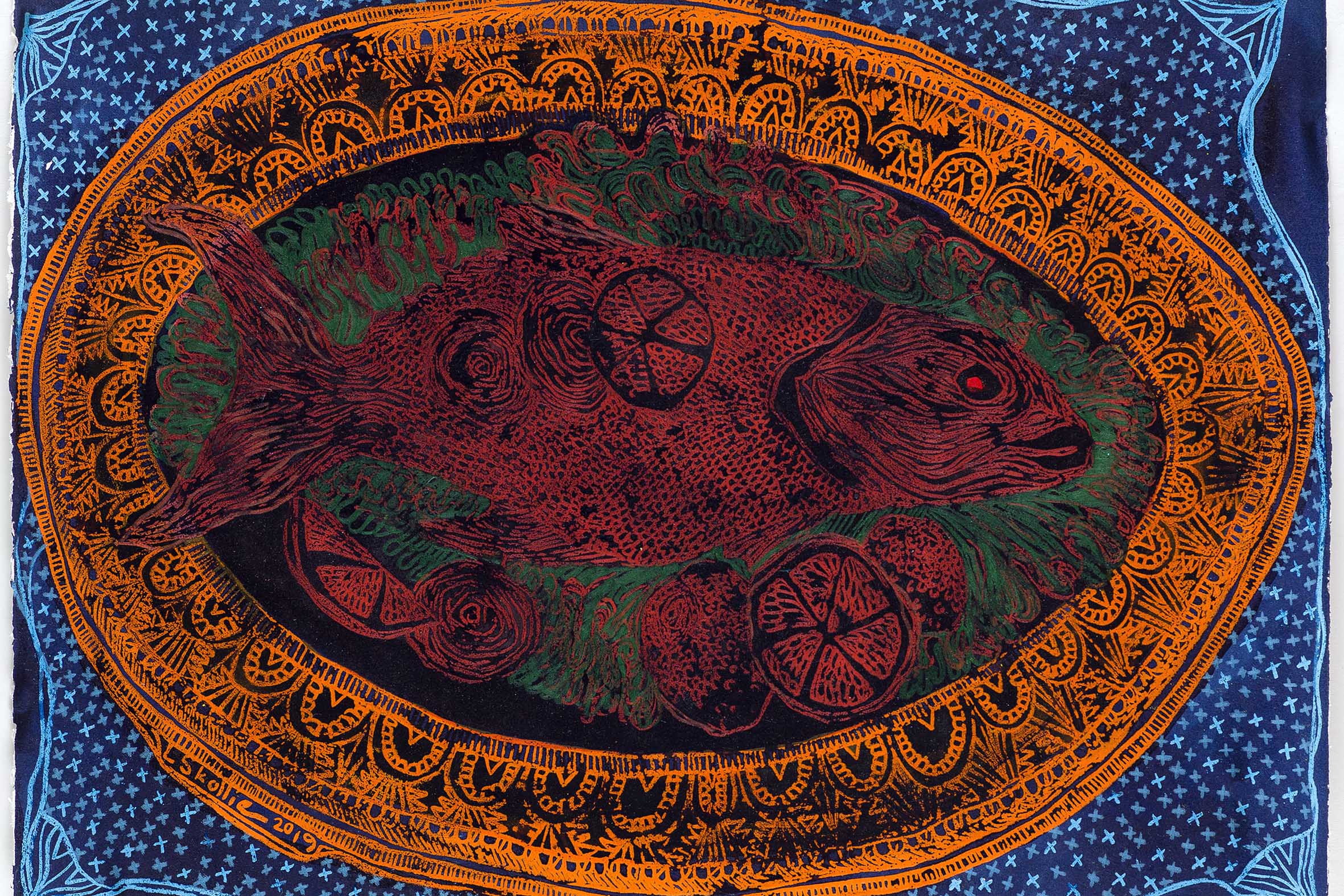
Undated: Lady Skollie’s Good & Evil exhibition included an ode to The Cape Malay Cookbook by Faldela Williams, published in 1988.
It makes sense that on reading a series of Cape Malay recipes, veteran Singaporean chef Violet Oon, who has deep ties to Malaysia, says: “Most sound alien to me and mainly southern Indian-influenced, probably over the centuries.” While chillies (usually in the form of masalas and pastes) are used, these Cape recipes lack the common Malay elements of shallots, belacan (shrimp paste), lemongrass and galangal, she explains.
Cape Malay cooks were forced to adapt dishes and over time would alter the nature of Cape cookery with the generous use of spices and herbs. They were sought-after, prized in the brutal system of slavery that commodified human beings. As Afrikaner historian C Louis Leipoldt sets out in Leipoldt’s Cape Cookery: “Undoubtedly the most potent influence on Cape cookery has been the methods, tastes and culinary customs of the Malay cooks.” In his accounts, it’s telling that Leipoldt details the artistry and cooking prowess of the female Malay cooks, crediting the Cape’s rich cuisine to their skill and cultural influence, yet rarely comments on their enslavement.
In search of definitions
But how do we define Cape Malay cookery when the history is complex and records unreliable?
It was only in 1988 that Faldela Williams, now deceased, became the first Cape Muslim cook to contribute to the mainstream narrative with The Cape Malay Cookbook. Previously, all published writers had been white and the recipes narrowly catered to their tastes.
Historian and chef Cass Abrahams would go on to challenge the status quo by declaring Cape Malay cuisine “food from Africa” in her 1995 cookbook, The Culture and Cuisine of the Cape Malays. It was the first time an author would publicise its creolised nature, giving credit to the veiled indigenous KhoeKhoe influences that were written out of the records. Within the Cape Malay community, traditionally this wasn’t a lineage widely acknowledged, as a higher value was placed on the Eastern roots. The 76-year-old Abrahams, who converted from Catholicism when she married into a Cape Malay family five decades ago, says she spent a significant part of her career treated as an outsider.
Huiskos: Food that stretches
Fatima Sydow, cookery show host and author of Cape, Curry & Koesisters, has had to deal with similar resistance. In her home on the Cape Flats, she says: “I’m sometimes told that I shouldn’t declare my recipes ‘Cape Malay’ because I’m not from the Bo-Kaap. I always say, Cape Malay is not a geography, it’s a lifestyle and it’s tied to your roots.”
While we speak, we share a hearty meal of lamb ahkni, a rice-based dish that reminds me of the chapters that Indonesian cookery expert Sri Owen, author of numerous books including The Rice Book, has dedicated to the subject and how prevalent rice is in the daily Cape Muslim diet, too.
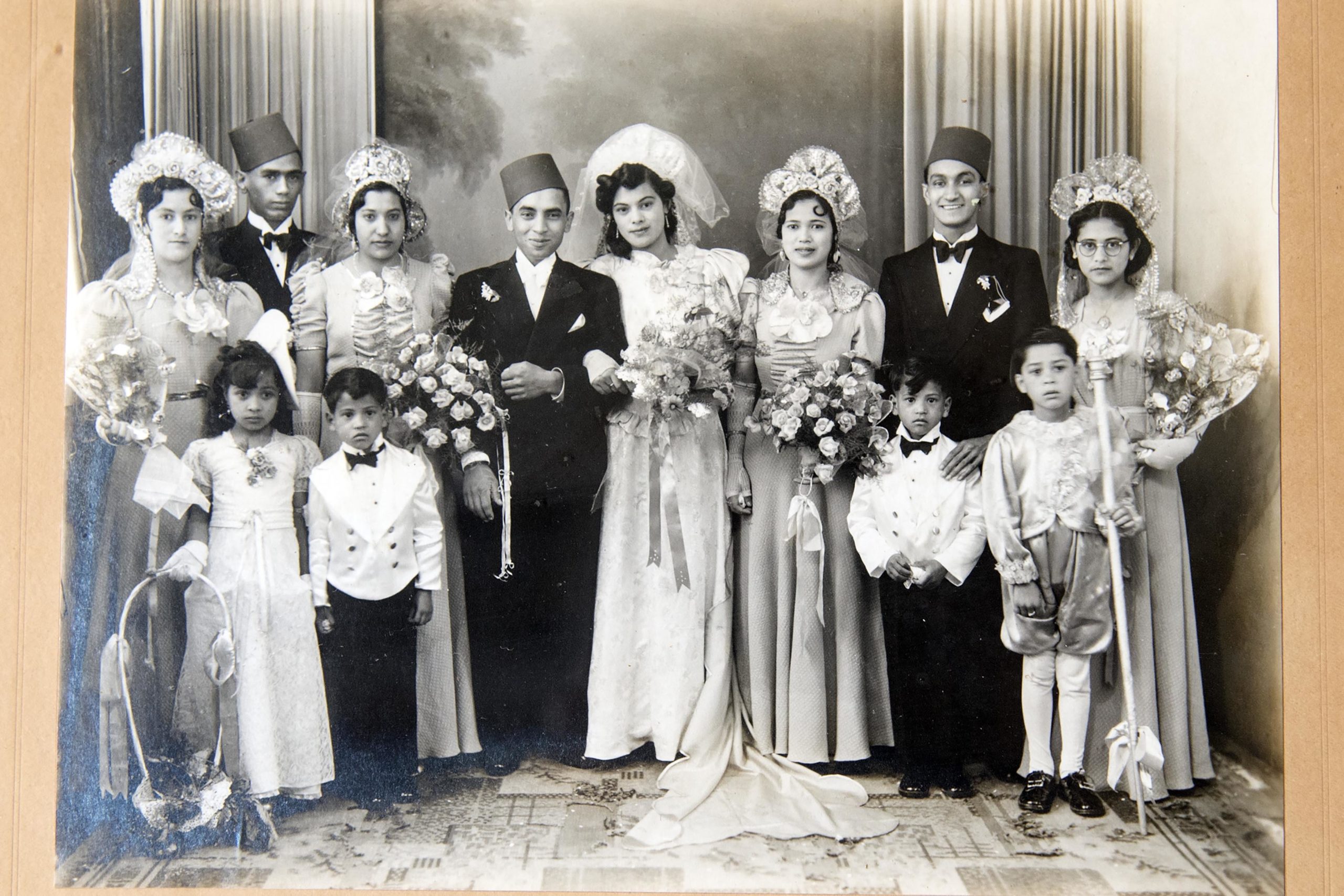
Undated: Cass Abrahams’ family in a picture from her photo album. (Photograph by Ishay Govender)
Growing up in District Six before his family was relocated under the Group Areas Act, independent archival researcher Mogamat Kamedien, whose forebears were from Aceh, defines Cape Malay cuisine simply as huiskos, or home food. A distinguishing factor, he says, is that the daily meal is economical (known as langsouskos, food that can stretch to feed many) and resplendent with spices, which even working-class families can afford.
Bredies, or stews, supplemented by vegetables and sauce, fall squarely in this category. Sydow has a recipe for green bean bredie in her cookbook to serve eight that calls for a meagre amount of meat. In her books, Owen uses the term “long cooking”, presumably for slow-cooked dishes, but I can’t help but liken it to lang sous – long sauce, when translated literally.
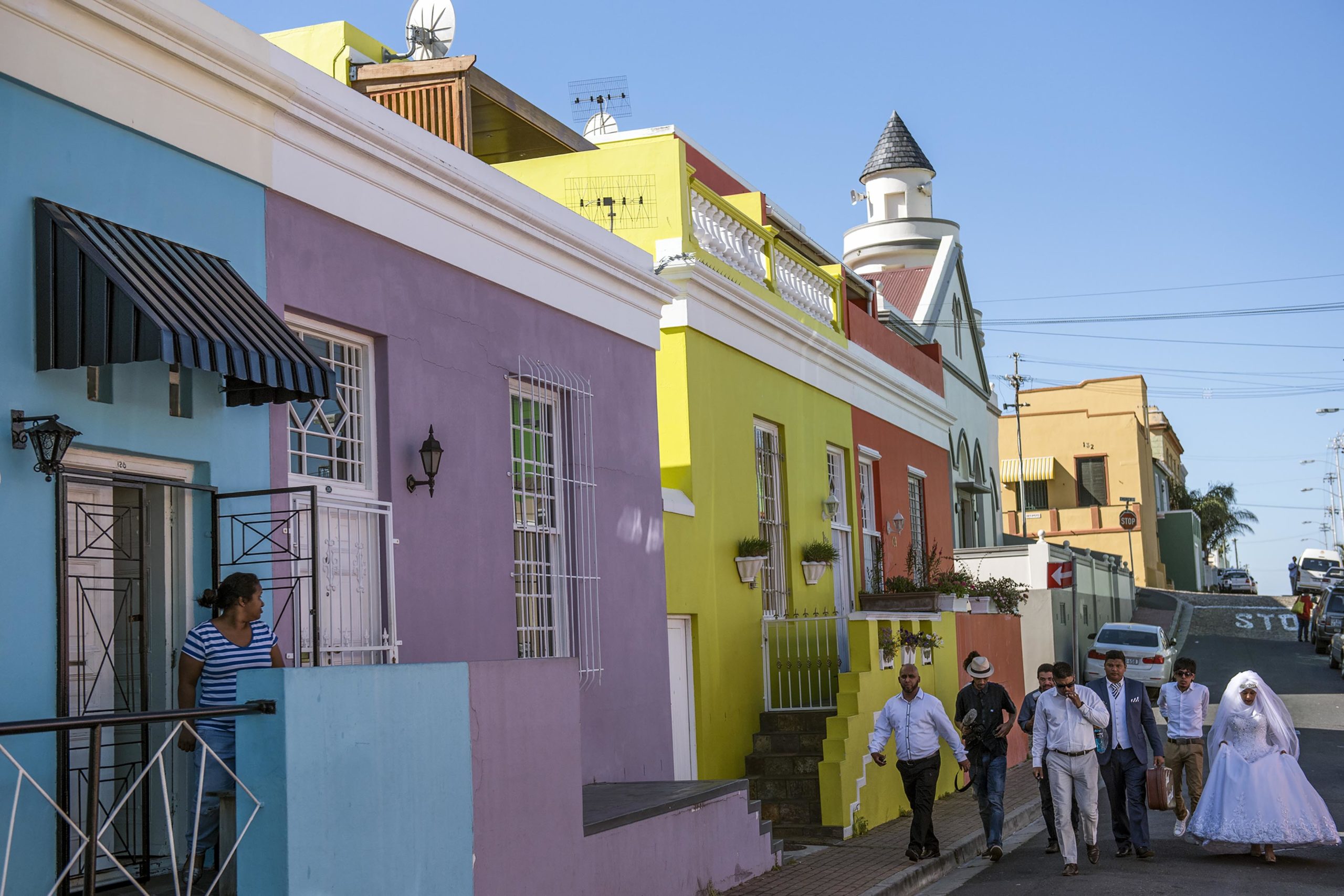
Undated: A Cape Muslim bridal party walks along the streets of the Bo-Kaap. (Photograph by Ishay Govender)
Kozain highlights that linguistic artefacts play a starring role in unpacking the cuisine that would have morphed over time, but perhaps became stagnant at a point, as Indonesian food modernised. “Food in the place of origin may have developed away from whatever dishes slaves brought to the Cape, the latter of which was also subject to radical development. [Consider] diverse people thrown together and limited traditional ingredients,” he says. “So what people in the broader region of Malaysia and Indonesia eat now may be at a remove from the 1600s to 1800s.”
Reaching out to Wongso and Owen, both replied that they have no familiarity with the Cape Muslim cuisine of the long-departed Indonesian slaves.
Similarities in language
When I travel to Indonesia and Malaysia to seek out the connection with Cape Malay cookery, Abrahams and Kamedien advise me to pay attention to similarities with the language used by Cape Muslims, particularly in Afrikaans. I trace the Indonesian words familiar to me: sop (soup), pisang (banana), terima kasih (thank you). Blatjang (chutney in Afrikaans) may be related to belacan, which is similar in pronunciation; a text from 1882 confirms this.
Then there’s bubur nasi, a savoury rice porridge like congee and the Cape boeber, a sweet milky vermicelli dessert fragrant with cinnamon and cardamom and served during celebratory occasions.
“So, bubur and boeber share some characteristics, but how does the same word come to describe two different items?” Kozain asks via email. “In boeber the idea of a porridge-like dish survives. But when and where does the concept of bubur mutate into boeber? For the romantic, it’s evidence of both roots and of the loss of roots.”

Undated: Cape Muslim cuisine is known for its liberal use of spices, which pay homage to its vast cultural roots. (Photograph by Ishay Govender)
Batokok means “to pound” and Abrahams links it to bobotie, a signature Cape dish prepared with spiced mince and baked with a whisked egg topping. There is a less spicy Afrikaner version, too, and tracing who made it first becomes futile because food inspiration travelled between conquered lands and conquerors, and vice versa, with wild abandon.
Consider sosaties, skewers of marinated meat similar to Malaysian satay or Indonesian saté. Dengdeng is a West Sumatran dish made from water buffalo or beef; some liken it to American jerky. It’s a thinly sliced, fried and pounded meat dish, heavy on the chillies. According to Sydow and Abrahams, dengdeng is the forerunner to the celebratory Cape dish called denningvleis (“Eaten when you have money for meat,” Sydow says), which is slow-cooked lamb or mutton prepared with black pepper and tamarind. It certainly carries the same rich colour as dengdeng.

Undated: Cape Malay chicken curry served with roti. (Photograph by Ishay Govender)
In Jakarta, in the absence of a link to the food of the long-lost slaves, Wongso takes me to an East Javanese restaurant, Oma Poppy, that showcases Dutch influences. He’s curious if Cape Malay cookery embodies any elements left behind by the Dutch colonisers. We enjoy croquettes with sweet mustard and braised beef tongue, the latter also prepared by Cape Muslims.
In the Cape, dishes appear to live dual lives of the enslaved and oppressors: koe’sisters and koeksisters, Cape Muslim and Afrikaner versions of bobotie, sosaties and bredies. It is a reminder of a line from Baderoon’s Regarding Muslims. She emphasises that even under the most oppressive and repressive conditions, enslaved cooks created a new language of food, and while influencing the palates of the oppressors in the process, Cape Muslims fashioned a cuisine that speaks to their complex, fragmented history, ingenuity and resilience. With this, they established one of the definitive cultural legacies of the Western Cape. DM/ ML
















 Become an Insider
Become an Insider